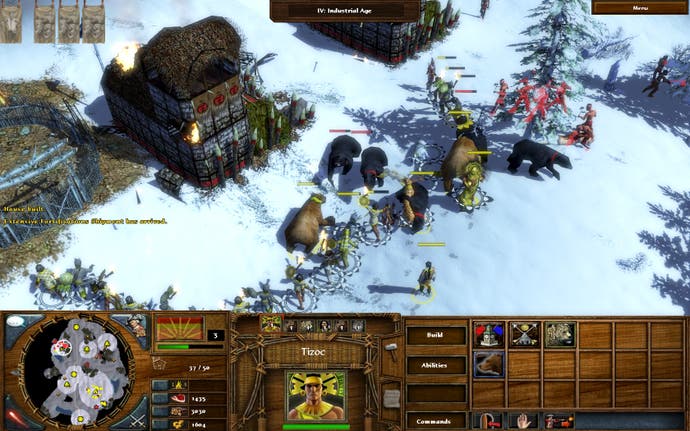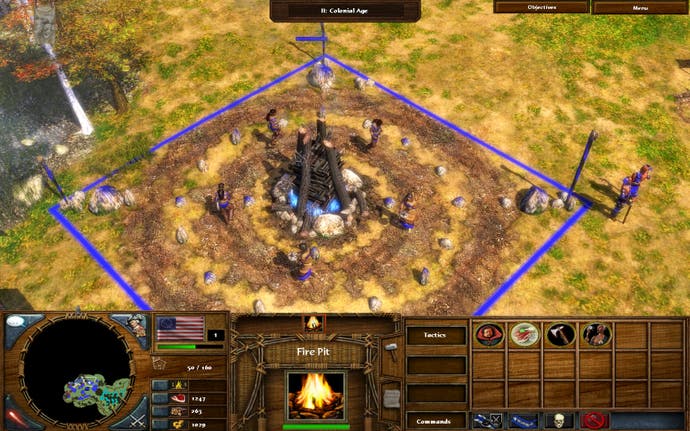Age of Empires III: The Warchiefs
Native format.
How d'you make a somewhat by-the-numbers, forgettable RTS better? Well, you could always just throw in some hypnotised bears. In fact, you could make a total raid of every book on Native Americans in the children's section of the library, and cheerfully shoe-in just about every fact, myth and cliché concerning the USA's long-suffering original inhabitants. So, as well as those mystically bewitched urisdae, we get similarly tamed cougars and wolves, spirit dances and magical medicine men. Everything short of transforming into a spectral hawk, in fact, but that may only be because Prey already tried that trick. Even so, this really isn't your large-bearded, pipe-smoking, stuffily accuracy-obsessed daddy's Age of Empires.
Making the three new races - Iroquois, Aztec and Sioux - semi-fantastical is a bold move, and one Ensemble has previously reserved for entirely separate games (i.e. Age of Mythology) rather than risk disgusted letters from Age of Empires' huge and stern contingent of history devotees. There's a sense that the internal debate on whether to ramp the crazy levels up to eleven was never quite resolved, as the single-player campaign actually dials it down hugely, after initially introducing wardances around the firepit and hero units with the power to mentally enslave.
Quickly escaping his rustic roots, the first act's Native American hero, Nathaniel Black, soon becomes intertwined with George Washington and his American resistance, and from then on it's pretty much business as usual, though at a rather more break-neck pace than in AOE3 vanilla. There's a bit of a back-to-front Last of the Mohicans vibe to it - the hero's called Nathaniel in both cases, but here he's of Iroquois descent rather than being a Frontier settler, and in both, there's a helpless, kidnapped woman holding out for a hero, but this time around she's been snatched by boo-hiss baddie German colonialists rather than the novel's evil Indians. The second act plays up the fiction even more, with Nathaniel's brooding grandson suffering a bit of an identity crisis and running into one General Custer.

Such schizoid flitting between history and vague attempts at movie drama works out surprisingly entertaining, though the tales are nowhere near as involving as the overdone gravitas suggests their creators thought they would be. Part of that's because the graphics engine isn't really up to cutscene work. It's still fairly good-looking a few months down the line from the original AOE3, but a lack of animations means that, rather than moving anything like naturally, characters do laughable stuff like spin 180 degrees on the spot instantly when they turn to face each other, like a two-sided cardboard cutout on a stick. Sure, it's a perennial problem for RTSs that need to spread their polygon count across dozens of characters rather than a handful, but it grates all the more when we're supposed to be taking the cutscenes as serious drama. But hey, it's an RTS expansion pack - the narrative segments were only ever going to be in-engine, or consist of Hollywood Advert Man intoning something tedious about destiny and vengeance as the camera pans slowly across a painting of some historical scene.
Nevertheless, its high-action approach means the singleplayer manages to be far more fun than a game that's still largely about chopping wood faster than the other side can entirely deserves to be. It gets you to try a bunch of different things, its challenge is consistent and the jump forward to the future in the second acts means a pleasing switch from increasingly tiresome American Revolution fare to cowboys & injuns scrapping it out during a Frontier gold rush.

It's in the multiplayer that Warchiefs really goes crazy, though. Bereft of the unit and narrative restrictions of the single-player, the comicbook Native American stuff comes to the fore. A lot of it's in the firepits, the only building in the AOE3 pantheon that requires interaction beyond build, place and queue up production. Point as many Villagers (AOE3's build unit) as you can spare at it, and they'll dance around it. You can then select one of a bunch of different rituals, each of which has a different effect on your game - you'll gain experience quicker, build faster, sporadically generate special units or, most importantly, fight better. Each of these is to a hugely significant degree rather than just a token boost. You get used to it, but initially it simply doesn't make any sense. So my Tomahawk throwers are stronger because there's six guys throwing shapes at the other end of the map? What? The sense of reality distorting only increases when you send a dozen angry jaguars off to fight a cannon, and that's before you've discovered that you can buy Ninja from the NPC saloons. Yep, Ninja. We're only one degree of RTS unit insanity away from knife-fighting monkeys here.
The madness is tempered by the three new races being impressively distinct, and requiring specific strategies. The Iroquois are closest to the European forces of the parent game, the Sioux cavalry-based and the Aztec pretty much exclusively infantry. Which probably explains why they became extinct in reality, but here their Elite units are surprisingly powerful, and the use of the firepit to augment their spear-chucking abilities absolutely vital. The old races get a few more units too, most notably (and disturbingly) some suicide bombers, but their biggest new draw is Revolution mode. It's a risky gambit, but, come the top level of the tech tree, it'll switch your entire Empire to a militaristic one with dramatically reduced resource-gathering and a bunch of uber-tough units.
All told, it's quite a lot of newness from an expansion pack, and in many ways makes for a pretty considerable shift from how the original game works. Not everyone's going to agree with me here, as Age Of Empires III certainly has its fans, but, for me, this is redemption (but only redemption & we're not talking elevation to high levels of acclaim) of a sort for the original game. I laughed one of those laughs that sounds a little like crying when I heard that AOE3 had scooped the Best Online Game award at this year's Golden Joysticks. What a baffling decision - it wasn't a terribly interesting game, it was just by the numbers RTS, and in many ways, pretty boring. I prefer my strategy over-the-top, even slightly silly, so being able to vanquish a foe by setting a horde of hypnotised bears on him is far more like my idea of fun.








